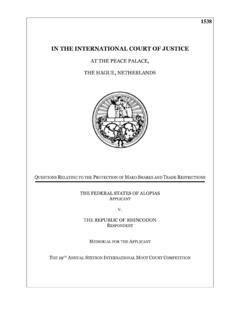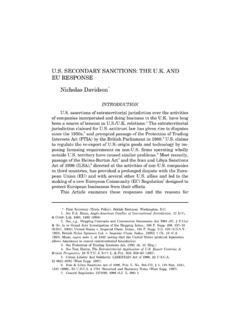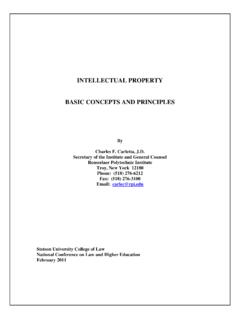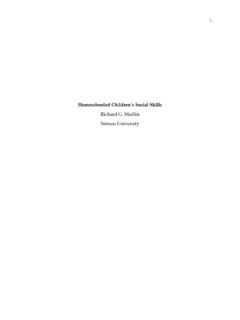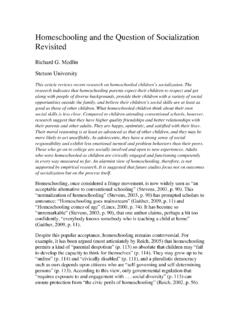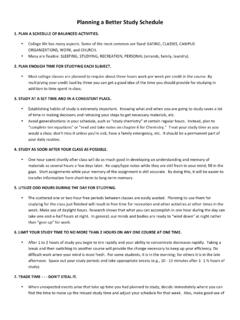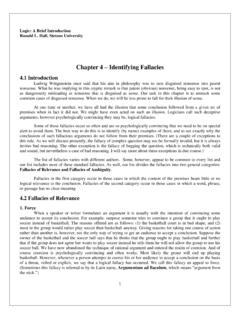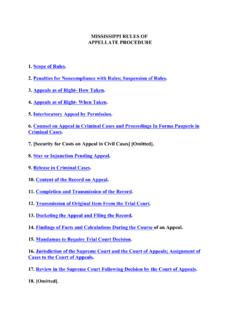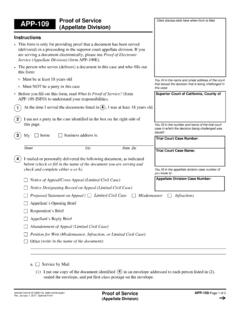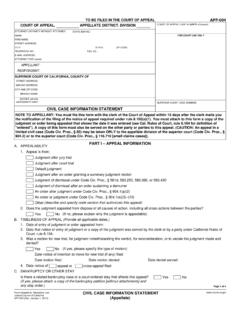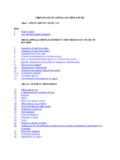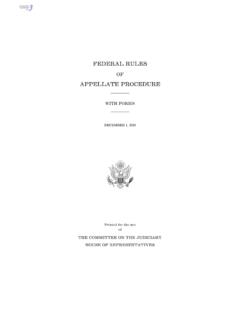Transcription of Stating the Case and Facts Foundation of the Appellate Brief
1 File: (2).doc Created on: 9/16/2002 3:41 PM Last Printed: 4/3/2003 12:21 PM Stating THE case AND Facts : Foundation OF THE Appellate Brief * Raymond T. (Tom) Elligett, Jr.** Hon. John M. Scheb** THE IMPORTANCE OF Facts Appeals focus on legal They are not a place to at-tempt to retry the But that does not dictate that counsel ignore the importance of the Facts in their briefs. Our common-law legal system is fact driven. A difference in the Facts may em-power the advocate to distinguish the client s case from what ap-pears to be a determinative adverse precedent. The Facts should neither be something counsel rushes through to write the argument section of the Brief , nor an after-thought.
2 The Brief s statement of the Facts stands as an integral and often crucial part of the Appellate process. Just as well-written Facts may make the case , poorly written or misleading factual statements may condemn the Brief to defeat and discredit its author. This Article offers suggestions on effectively conveying * Adapted from Chapter 9 of Raymond T. Elligett, Jr. & John M. Scheb, Florida Appellate Practice and Advocacy (2d ed., stetson U. College of L. 2001). ** 2003, Raymond T. (Tom) Elligett. All rights reserved. Member, Schropp, Buell & Elligett, Mathematics, university of Florida, 1975; , Harvard Law School, 1978.
3 He is board certified in Appellate practice and is an adjunct professor teaching appel- late practice at stetson university College of Law. He is a past chair of the Florida Bar Appellate Practice and Advocacy Section and was President of the Hillsborough County Bar Association in 1997 98. He is a Master in the Justice William Glenn Terrell Inn of Court. ** 2003, Hon. John M. Scheb. All rights reserved. Senior Judge, Florida court sys-tem. , university of Florida, 1950; , Florida Southern College, 1980; , Judi-cial Process, university of Virginia, 1984. Judge Scheb practiced law in Sarasota from 1950 1974, serving as city attorney for the city of Sarasota from 1959 1970.
4 In 1974, he was appointed a judge on the Second District Court of Appeal, a position he held until his retirement from that court in 1992. During the 1990s, Judge Scheb served as a distin-guished professorial lecturer at stetson university College of Law, where he taught appel- late practice. He is past President of the Sarasota County Bar Association and is a Master in the Judge John M. Scheb American Inn of Court. 1. Paul R. Michel, Effective Appellate Advocacy, 24 Litig. 19, 19 (Summer 1998). 2. Id. File: (2).doc Created on: 9/16/2002 3:41 PM Last Printed: 4/3/2003 12:21 PM 416 stetson Law Review [Vol.]
5 XXXII the Facts in an Appellate Brief . The same principles should apply in a trial court Brief . STATEMENT OF THE case After counsel has reviewed the record, identified issues, and reviewed the Rules,3 it is time to prepare the Statement of the case . In some instances, it may be advisable to combine it with the Statement of the Facts . Unlike the federal rules, Florida s ap-pellate rules leave this to the writer s discretion. The appellant s Statement of the case should be completely objective, and never slanted. The appellant should show the ap-pellate court that it has jurisdiction, what the disposition was in the lower tribunal, at what point the order appealed from was entered, and whether the case was a jury or nonjury trial.
6 Par-ticularly, if timeliness of the appeal may be an issue, the appel-lant should mention the date the order being appealed was en-tered and the date the notice of appeal was filed. If a timely filed and authorized motion under Rule (h) postponed rendition, the appellant should relate that to the date the notice of appeal was filed. The appellee should make any necessary corrections, but if none are needed, the appellee should indicate agreement with the appellant s Statement of the case . Counsel should include only those dates and details necessary to the issues on Counsel should not clutter the Statement of the case or Facts with unimportant dates or pleadings.
7 In most appeals, the date the plaintiff filed the complaint is irrelevant, as are the dates of the answer and various motions. The Brief should not recite motions, discovery, or other activities that do not bear on the Appellate issues. For those rare cases in which multiple dates or events are important for either substantive or procedural issues, counsel may consider including a chronology to assist the court. 3. We refer to the Florida Rules of Appellate Procedure as Rules, and the Federal Rules of Appellate Procedure as FRAP. 4. Leonard I. Garth, How to Appeal to an Appellate Judge, 21 Litig.
8 20, 24 (Fall 1994). File: (2).doc Created on: 9/16/2002 3:41 PM Last Printed: 4/3/2003 12:21 PM 2003] Stating the case and Facts 417 Counsel must cite to the record for assertions in the State-ment of the case or Counsel should not make the judge or the judge s law clerk forage through the record to find documents or testimony referred to in the Statement. Rule (b)(3) re-quires references to the appropriate volume and page number of the record or Appellate JUDGES EMPHASIZE THE Facts Several Appellate judges note that they begin to focus and analyze the issues when reading the Statement of the Facts .
9 While the advocate cannot change the Facts , he or she can show how they relate to the case law. Judge Leonard I. Garth of the Third Circuit observes that courts are usually familiar with the relevant case law, and they look to counsel to educate them on how those apply to the Facts of the case before While one must do so within the limits discussed below, other judges urge that the Facts be written so the judge reading the Facts wants to rule for the And they recommend that the party s theme or themes permeate the Brief , including the State-ment of the Selecting the Facts Judge Paul R.
10 Michel of the United States Court of Appeals for the Federal Circuit emphasizes that Appellate judges need to grasp the essential Facts . 10 Just as for the Statement of the case , advocates should be selective in including Facts relevant to the points on Judge Michel warns that if judges face an avalanche of unnecessary information, they may miss the is-sues, Facts and authorities that 5. Fed. R. App. P. 28(a)(7) (2002); Fla. R. App. P. (b)(3) (2002). 6. Fed. R. App. P. 28(e) ( Stating that counsel must clearly refer to the original record or an appendix when making an assertion in the Brief ).
